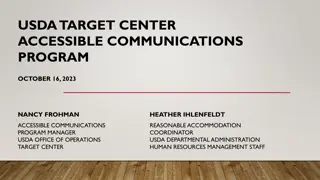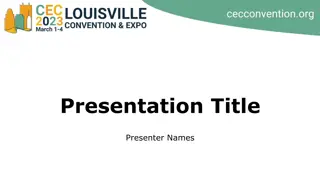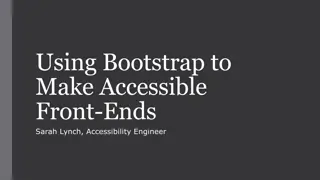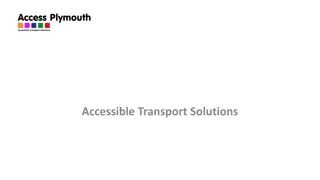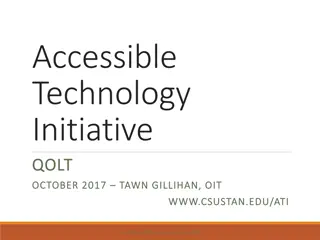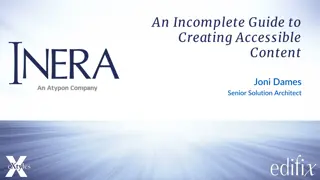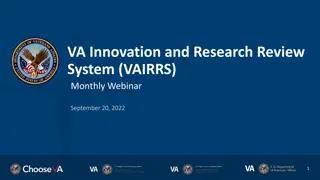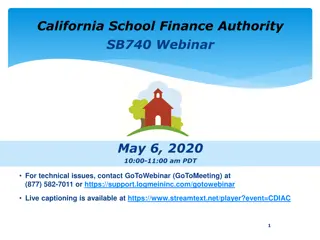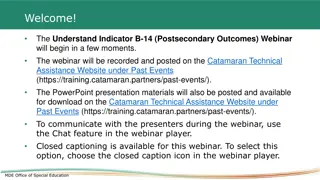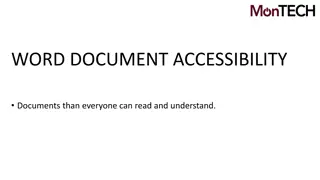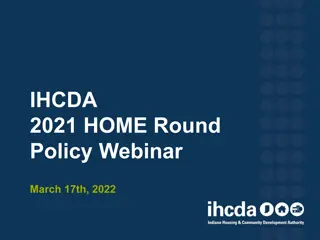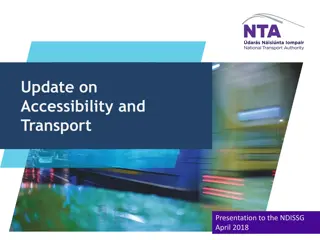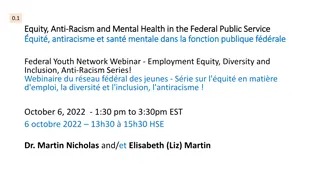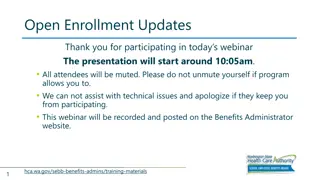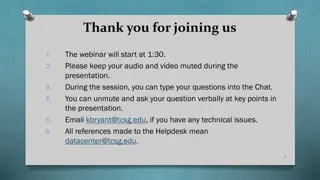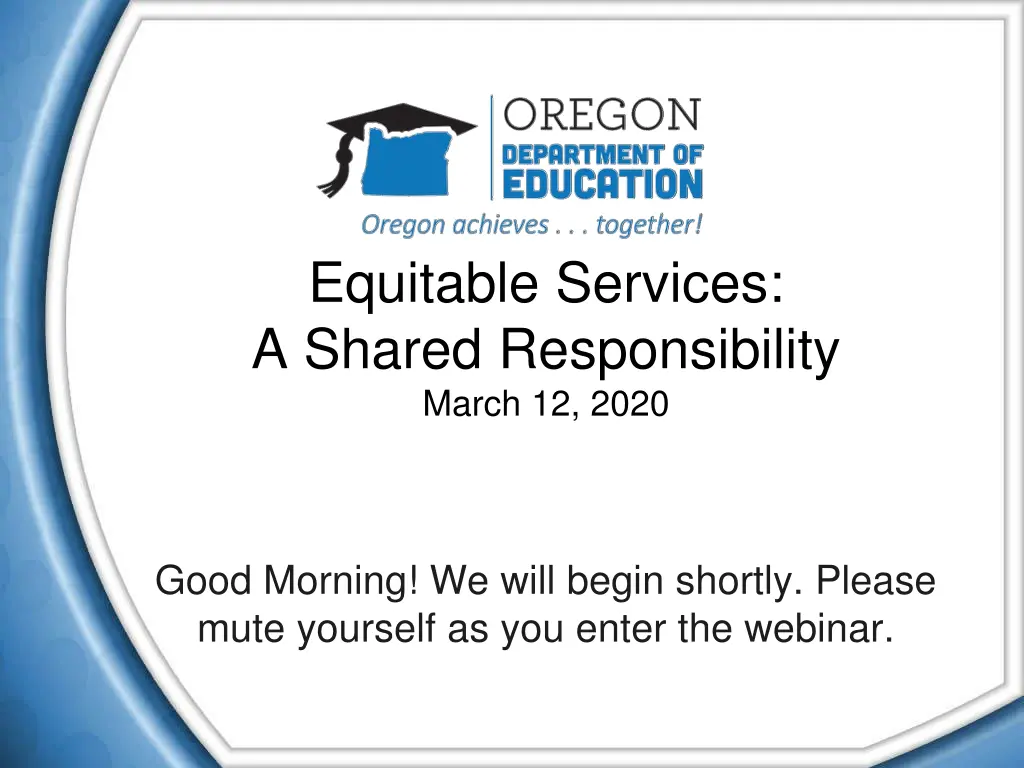
Equitable Services: Shared Responsibility in Federal Programs
Explore the essential aspects of equitable services and shared responsibility in federal programs, including a review of ESSA, applicable federal programs, consultation processes, specific program details, and changes under ESSA. Learn about basic premises, nonprofit status definitions, and the implications for schools and organizations.
Download Presentation

Please find below an Image/Link to download the presentation.
The content on the website is provided AS IS for your information and personal use only. It may not be sold, licensed, or shared on other websites without obtaining consent from the author. If you encounter any issues during the download, it is possible that the publisher has removed the file from their server.
You are allowed to download the files provided on this website for personal or commercial use, subject to the condition that they are used lawfully. All files are the property of their respective owners.
The content on the website is provided AS IS for your information and personal use only. It may not be sold, licensed, or shared on other websites without obtaining consent from the author.
E N D
Presentation Transcript
Equitable Services: A Shared Responsibility March 12, 2020 Good Morning! We will begin shortly. Please mute yourself as you enter the webinar.
ODE Team Deb Lange, Director deb.lange@state.or.us Joni Gilles, Ombudsman joni.gilles@state.or.us Stacie Ankrum, Administrative Assistant Stacie.ankrum@state.or.us Lisa Plumb,IA and IVA Federal Program Specialist lisa.plumb@state.or.us Jen Engberg, IA Federal Program Specialist jennifer.engberg@state.or.us Sarah Martin, Title IIA Program Specialist sarah.martin@state.or.us Susy Mekarski, Title III Program Specialist susan.mekarski@state.or.us
Overview of Todays Session 1. Introductions 2. ESSA---a Review (Basic Premise, Non-Profit Status) 3. Applicable Federal Programs 4. Consultation 5. Specific Federal Programs (IA, IC, IIA, III, IVA, IVB) 6. Revised Federal Guidance (Title IA) 7. Carryover 8. Transferability 9. A+ Monitoring 10. Questions/Comments/Resources
Who is on-line and in the room? School District Administrators Private School Administrators ODE Program Staff Other
Changes with ESSA A Review Ombudsman Expanded Consultation Affirmation of Consultation No Carryover (latest iteration) Transferability
Equitable Services: Basic Premise Federal programs are supported by tax dollars, so all children and teachers (both public and private) are eligible to access these programs.
Defining Nonprofit Status Under 34 CFR 77.1, the term nonprofit as applied to an agency, organization, or institution, means that it is owned and operated by one or more corporations or associations whose net earnings do not benefit, and cannot lawfully benefit, any private shareholder or entity. Source ED Office of General Counsel
Church School Nonprofit Status If a church that operates a school meets the definition of non-profit , the school does not need separate nonprofit documentation. *Source ED Office of General Counsel
Applicable Federal Programs Equitable services requirements for non-public/private schools apply to programs under 1117 or 8501: Title I, Part A (Improving Basic Programs) Title I, Part C (Migrant Education) Title II, Part A (Supporting Effective Instruction) Title III, Part A (English Language Acquisition) Title IV, Part A (Student Support & Academic Enrichment) Title IV, Part B (21st CCLC)
CONSULTATION The of Equitable Services
Consultation GOAL of consultation: reach an agreement between the school district and private school officials on how to provide equitable and effective programs for eligible private school children. TIMELY Before the LEA makes any decisions During the design and development of program Throughout the implementation and assessment of services MEANINGFUL Genuine opportunity for parties to express their views Views seriously considered LEA may initiate consultation with a proposal for services Consultation must occur before final decision are made by LEA ONGOING
Timely and Meaningful Consultation Consultation should Consultation should not Provide ample time and genuine opportunity: for all parties to express their views, to have their views seriously considered, and to discuss viable options for ensuring equitable participation. Include pre-determined program decisions (including transferability) with no input from all parties, such as: already established third party contract, already determined services, and already established timelines.
Consultation (District Responsibilities) Identify private schools within district boundary Develop annual consultation calendar Send out consultation invitation letter (adequate notice typically 2 to 3 weeks) Establish LEA and private schools roles and responsibilities Discuss/exchange applicable LEA and private school fiscal and program policies Discuss and require private school signature of Federal requirements governing the provision of federally funded services (In toolkit https://www.oregon.gov/ode/schools-and- districts/grants/ESEA/Pages/ESEA-Monitoring.aspx ) Access existing resources to guide collaboration Document, document, document!
Ongoing Consultation Efforts and Documentation On going consultation can be conducted in person, via e-mails, by mail, and through LEA-organized meetings. It is important that LEAs document their efforts and the ongoing communication between them and the private schools. Documentation can include e-mails, phone call logs, letters, attendance sheets, meeting agendas, webinar information, etc.
Topics of Consultation by Title Program I II III IV How the district will identify the needs of eligible non-public school children and their educators a. What services the district will offer to eligible non-public school children and their educators a. How and when the district will make decisions about the delivery of services a. How, where and by whom the district will provide services to eligible non-public school children, including a thorough consideration and analysis of the views of the non-public school officials on the provision of services through a contract with a third-party provider a. How the district will assess academically the services to eligible non- public school children and how the district will use the results of that assessment to improve services a. The size and scope of the equitable services that the district will provide to eligible non-public school children and the proportion of funds that will be allocated to provide these services, and how that proportion of funds is determined a. The method or sources of data that the district will use to determine the number of non-public school children from low income families residing in participating public school attendance areas, including whether the district will extrapolate data, if a survey is used a. The equitable services the district will provide to teachers and families of participating non-public school children a. Whether the district shall provide services directly or through a separate government agency, consortium, entity, or third party contractor a.
Topics of Consultation by Title Program Whether to consolidate and coordinate the use of funds to eligible private school children: I II III IV a. by creating a pool or pool of funds with all the funds allocated under Titles I, II, III, and IV; or on a school-by-school basis based on each the proportionate share of funds available to provide services in each school When, including the approximate time of day, services will be provided a. The option for private school officials to indicate such officials belief that timely and meaningful consultation has not occurred or that the program design is not equitable with respect to eligible private school children a. How the LEA administrative costs were determined a. AFFIRMATION OF CONSULTATION (must be sent to Ombudsman within 30 days of consultation with private school) Districts may continue to use TransACT form PS-02 (Verification) or the Affirmation of Consultation form posted in Private School Equitable Services Toolkit https://www.oregon.gov/ode/schools-and- districts/grants/ESEA/Pages/ESEA-Monitoring.aspx All documentation (i.e.; agendas, invitations, meeting notes/minutes should be maintained at the district level)
Responsibilities (SEA and LEA) SEA Designate Ombudsman Collect district Affirmation of Consultation forms Provide technical assistance Mediate, investigate and resolve conflicts Conduct oversight and monitoring LEA Conduct/document ongoing, timely and meaningful consultation Provide services that meet the needs of PS students and staff Allocate proportionate share for equitable services Assess/evaluate programs Obligate funds in the year they are received
Responsibilities (Private School) Attend consultation Conduct annual needs assessment Provide necessary reports/documentation to district when requested Identify method for evaluating effectiveness of programs Work with the district to arrange for billing and payment
Consultation Best Practices Inform private school officials annually (late winter) Engage in timely and meaningful consultation (ongoing) Identify needs (early spring) Determine per pupil amount for private school services equal to per pupil amount for public school services (late spring/ early summer) Discuss logistics of program operation (summer) Provide services, programs, materials, and resources (to begin in fall and continue throughout the school-year) Minimum of one on-site visit (November through March) Evaluate programs and services for effectiveness (spring) This is one of many suggested timelines. Many districts have developed plans that meet the needs of the district and their private schools.
Opportunities for Collaboration District Professional Development activities Updates on any new legislation that may apply to private schools A Summary of Enacted Education Legislation (2019 Regular Session) https://content.govdelivery.com/attachments/ORED/2019/08/1 4/file_attachments/1266693/2019%20Summary%20of%20En acted%20Education%20Legislation%20.pdf Senate Bill 155 https://olis.leg.state.or.us/liz/2019R1/Downloads/MeasureDoc ument/SB155/Enrolled http://www.osba.org/News- Center/Announcements/2019/20190808SB155.aspx
TITLE I Improving Basic Programs
Guiding Principle of Title IA Equitable Services Benefit the individual child and not the private school Are provided by LEA and not the private school
An LEA must only use Title IA funds to meet the needs of Title IA participants. Consequently . An LEA cannot use any Title IA funds to meet the needs of the private school or the general needs of the private school children. Private schools may not operate schoolwide programs Funds may never be paid directly to the private school Services should begin when public school services begin
Title IA Allocation is generated by low-income students who by age and address would have attended a public Title IA school. Services are provided to eligible students identified as having the greatest need. All students who would have attended a Title IA school in the district are eligible for Title IA services in the private school regardless of socio-economic status. Title IA provides supplemental instruction by appropriately licensed teachers. LEA maintains responsibility for Title IA services and resources. Services are secular, neutral, and non-ideological and address the needs of the eligible private school students.
Title IA: Process for Determining ALLOCATION and SERVICE Private school determines (registration form) the resident district for each student Private school determines poverty level of all students (most commonly used is free and reduced lunch data; although there are 4 methods) Private school sends districts a list of all students residing within district boundaries and their poverty level District determines which student reside in a Title IA school attendance area District sends private school list of ALL students in Title IA school attendance area Private school screens ALL students from district list to determine academic need during (i.e. DIBELS, CBM etc.) Private school ranks students with highest needs ALLOCATION is determined by poverty AND residence SERVICE is determined by need AND residence https://www.oregon.gov/ode/schools-and-districts/grants/ESEA/Pages/ESEA-Monitoring.aspx
Private School Low Income Calculation LEA has the final authority to calculate the number of children, ages 5-17, who are from low-income families and attend private schools by Using same measure of low-income as public schools Using the results of a survey Applying the low-income percentage of each participating public school attendance area Using an equated measure of low-income correlated with the measure of low income used to count public school children Section 1117(c)(1)(A-D)
Private School Responsibilities (Title IA Specific) Provide LEA with grade and address for each PS student so that LEA can determine if student is eligible for Title IA services. Provide LEA with student s socio-economic status so that LEA can determine if the student generates Title IA funds. Using multiple assessments, determine students in greatest need of Title IA services. Rank order students by greatest need for Title IA services.
Title IA Equitable Services The Title I non-public equitable share is based on the percentage of non-public low income students residing in Title IA participating schools Example: Total Public Low Income: 1,350 Total Non-public Low Income: Total Low Income: Percentage of Non-public Low Income: 10% (150/1,500) 150 1,500
Determining Equitable Services: Allocations .52% of Total Allocation taken out on District Set Aside
!Equitable Services:Important Distinctions! Private schools are targeted assist schools and only those students identified as being at risk for academic failure can be served Although a student may generate funds because of residence and poverty, the student may not be at risk of academic failure so would not be eligible for services.
Title I Instructional Services Provider of Title IA services must be either an employee of the LEA or an employee of a third party under contract with the LEA. Private school teachers may be employed by both the private school and the LEA; however, they must be independent of the private school during the time they are employed by the LEA to provide Title IA services.
Common Title IA Activities Tutoring Paraprofessionals Summer school Supplies/materials Professional development Extended day programs Computer assisted instruction
Evaluating the Title IA Program After consulting with private school officials, the LEA must establish standards it will use to measure the effectiveness of the Title IA program being provided to private school children. After consultation, LEA establishes the assessment it will use to measure the effectiveness against the agreed upon standards. May use the State assessment or another assessment that is aligned to the agreed upon standards, such as the assessment used in the private school. All participants are assessed annually, including children receiving nonacademic services.
Evaluating the Title IA Program If the expected annual progress is not met, the LEA, after consultation, must review its program and determine modifications it should make in order to improve the effectiveness of the Title IA program in raising the achievement of private school participants.
!CONSIDERATIONS! Title IA funds may not be used for screening assessments Services may be delivered directly through district or indirectly through contracts with public & private organizations/ individuals District controls all funds, materials and equipment Delivery of services must be neutral, secular and non-ideological Services for private school students must be for the same grade span as the services provided for public school students
!CONSIDERATIONS! The private school must notify families of their student s participation in the Title IA program (sample letter in Toolkit) Spring calculations are an estimate and may change with final allocation amounts from ODE Private school officials have no authority to obligate or receive federal funds. No federal funds may be paid directly to a private school A private school may never be reimbursed for materials/supplies purchased for Title programs Services must hold reasonable promise that the academic performance of private school students will improve Annually, the district must access the annual progress of the Title IA program
TITLE IC Migrant Programs
MEP Services: Two Examples The agency that operates the local MEP program is responsible for consultation requirements. Salem-Keizer School District (district operates its own MEP) Medford School District (part of Southern ESD Consortium) https://www2.ed.gov/programs/mep/mepnonregulatoryguidance317.docx
TITLE IIA Supporting Effective Instruction
Purpose of Title IIA Ensure equity of educational opportunity Attract, select, place, support and retain excellent educators Provide greater access to effective educators to students of low-income families and minority students Prepare students to succeed in college and career Build systems of support for educators
Requirements 1. Needs Assessment What is our data telling us? 2. Budget Narrative What will we do? - Strategies and activities to meet needs - WHAT is the intended objective? - WHO will participate? - HOW will impact be measured? - Meet USED definition of professional learning - sustained, classroom-focused 44
Professional Learning Strategies and activities must meet USED definition high quality, sustained, intensive, and classroom-focused in order to have a positive and lasting impact on classroom instruction and the teacher s performance in the classroom and not 1-day or short-term workshops or conferences. [ESEA Section 8101(42)] Conferences and workshops are approvable when they are included as part of larger strategy, not as an end in themselves How is the conference part of a sustained, job-embedded plan for professional learning? What is the plan for delivering the content so that the learning extends beyond those who attended?
Common IIA Strategies Evaluation and support systems Collaborative learning (PLCs, peer observations) Teacher leadership (Instr. Coaching, mentoring) Recruiting and retaining effective teachers Technology integration Using data to inform instruction Differentiating instruction PL focused on abuse, trauma and mental illness Well-Rounded Education CTE and STEM
Title IIA and IVA: Calculating Equitable Services Proportional Share Example of Formula to Determine Amount for Title IIA and IVA A. Number of Students A1: LEA Enrollment A2: Participating Nonprofit Private School Enrollment A3: Total Enrollment (A1 + A2) 900 100 1,000 B. Title IIA and IVA Allocation B1: Total LEA Allocation B2: LEA Administrative Costs (for public and nonprofit private school programs) B3: LEA Allocation minus Admin Costs (B1 B2) $10,000 $200 $9,800 C. Per Pupil Rate C1: Available Per Pupil Allocation for Equitable Services (B3 A3) $9.80 D. Equitable Services Amount LEA must reserve for equitable services for nonprofit private school children, their teachers, and other educational personnel (A2 x C1) $980
Important Reminders Private school activities are based on the school s needs assessment Non-Allowable Salaries/benefits Substitutes Religious content Schools may not be reimbursed the district is the fiscal agent
Evaluating Title IIA Programs Did the strategies happen? (Occurance) Attendance at trainings, completed coursework, contract signed/FTE hired Were the strategies put into practice? (Implementation) Observations/walkthroughs, coaching logs, PLC notes What were the results? (Impact) Surveys, student outcome data, changes to teacher practice, educator evaluation data
TITLE III English Learners and Immigrant Youth

